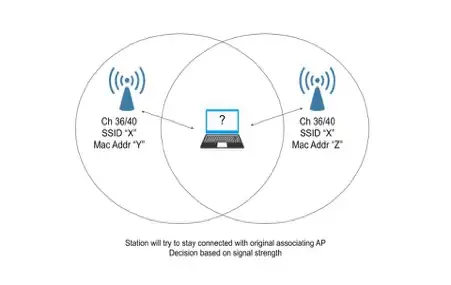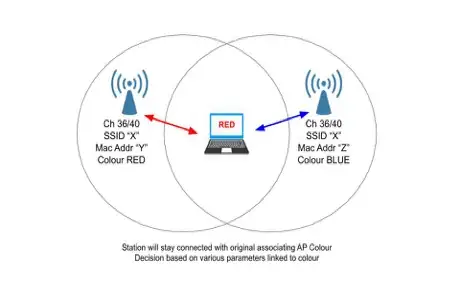What’s Really Cool About WiFi 6
Most of our vendors are releasing or announcing new WiFi technology. This started with announcements late last year and now this equipment is being made available. We have ordered some and will be starting our own testing.
 Aruba 550 (802.11AX)
Aruba 550 (802.11AX)
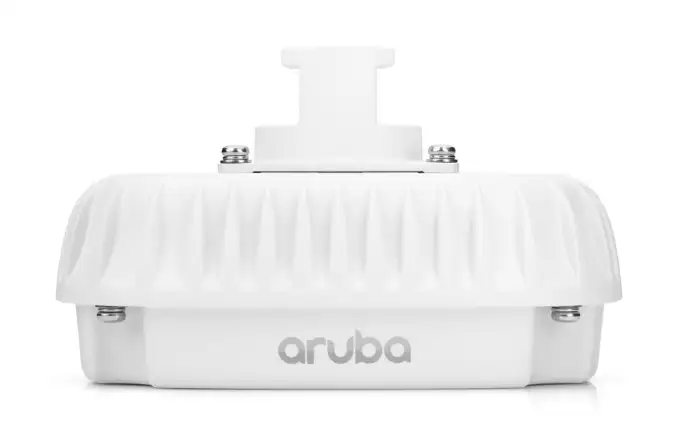 Aruba 387 (802.11AD/AC)
Aruba 387 (802.11AD/AC)
There are two new standards being implemented, 802.11AX and 802.11AD. 802.11AX is being branded WiFi6. WiFi5 is 802.11AC (wave 1&2) based technology and WiFi4 is 802.11n. I have been tracking the availability of chipsets from mainstream vendors like Intel, Broadcom and Qualcomm. The WiFi6 technology is being engineered into the latest mobile phones, laptops, consumer equipment, IOT and core infrastructure.
802.11AD (not yet branded) operates in the 60GHz spectrum and has very high throughput of 7-8Gbps, however the range is dramatically impacted by the frequency being used. This is very new and my feeling is that it will be used to create a backhaul capability for external AP’s.
Yet again, this is an example of technology being made available before the standards have been ratified. This means that vendors won’t be able to implement the full set of capabilities available to them in the standards – but that’s not unusual.
We have already begun designing WiFi6 capable infrastructure for some clients, which has an impact on the core switching, cabling and network design. I think WiFi6 will also have a significant impact on connectivity. I want to highlight some of what I think are the key features of this new technology and the impact it will have to clients networks.
WiFi6
The 802.11AX standard offers backward compatibility so it works with legacy technology, but also offers many very significant improvements. It changes how we design WiFi networks for organisations that depend (or want to) on their wireless connectivity.
In the standard at this stage, I see that there are four main areas of improvement:
- Data rates at the media access level increase dramatically.
- Management of the spectrum especially within a cell (a cell is defined by a radio using a channel with its RF physical coverage).
- Channel re-use
- Intra cell communications (possibly)
Data Rates and Impact to Designs
The new standard introduces a higher modulation rate (how much data is transferred in each transmission) of 1024QAM. The Wifi5 standard had a maximum modulation rate of 256QAM and this could only be used in channel widths of 40MHz and above. This is significantly faster and in my opinion, a big leap in low cost – low power technology.
The new WiFi6 supports 234 sub carriers in a 20MHz channel vs 52 in a WiFi5 20MHz channel. This means it has the capacity to potentially send roughly four times the information for each data set transmission (a symbol or set of data is transmitted every 12.8uS). However, the real data throughput maximum is only 37% faster.
The sub carriers for WiFi6 have other uses that are defined in a protocol called Orthogonal Frequency-Division Multiple Access (OFDMA), which is some of the really cool improvements to this new standard. More on this later.
The challenge in using higher the modulation rates is that they need better signal over noise, or higher Signal to Noise Ratio (SNR). This will mean designing WiFi systems to different standards, more specifically how many Access Points (AP’s) are used and proximity to the client devices. See the table below:
Standard Details Spectrum / Speed / Min receive level Range Open (M) Range Complex (M) 802.11a(WiFi3) Data rate in a 40MHz channel per stream is 150Mbps rcv -65dB 26 12 802.11ACw2(WiFi5) Data rate in a 40MHz channel per stream is 200Mbps – rcv -54dB 11.5 6.5 802.11AX(WiFi6) Data rate in a 40MHz channel per stream is 286Mbps – rcv -48dB 7.5 4.2Open = Open and clear office space
Complex = Complex and cluttered office space
To provide some perspective, some clients have had WiFi systems designed using radio surveys, where we have specified a minimum signal strength such as -62dBM. This won’t be enough for the new technology.
Many new buildings have been designed with wiring standards that work with an AP operating to a radius of 12-13M. TRR-24704 and TIA-TSB-162-A are two standards for example. The table above shows that many organisations will need to re-cable! That is, the radius could be as low as 4.1M!
They have also introduced longer guard intervals with WiFi6, which is the space (time) allowed between transmissions to minimise transmission collisions between stations/AP’s. They have no doubt done this to improve radio cell data throughput reliability (low error rates and fewer collisions). So on the one hand, they have dramatically increased the data speed, but then they have reduced time available to transmit, which will slow things down a bit.
Spectrum Management
One of the more interesting facets to the new WiFi6 standard is the new set of spectrum management capabilities. This is where I think things will be pretty interesting.
The OFDMA technology allows for the AP’s to assign the sub carriers (discussed earlier) to particular groups called Resource Units (RU). These are effectively sub channels and they can be assigned specific bandwidths. So within a wifi channel we can assign other sub-channels that won’t interfere with the main WiFi cell. It means we could have users happily using the internet in a normal way, but things like IOT devices can be chattering away slowly without impact to the main cell. This also means we can break up a WiFi channel and assign it to different types of devices based on their bandwidth and throughput requirements.
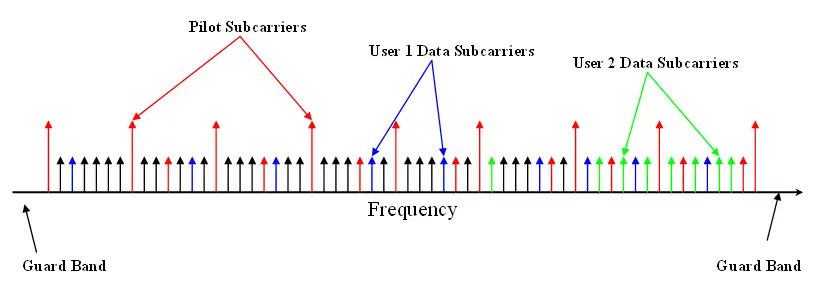
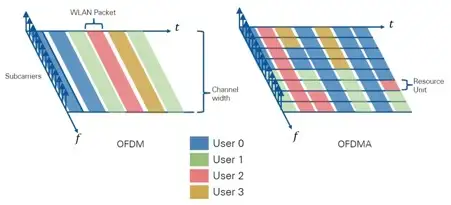 Picture from National Instruments
Picture from National Instruments
Channel Re-use
The other facet they have introduced is the concept of “colouring”. It means that devices can transmit packets and based on the colouring, decide to transmit re-using the same channels. It means that we could potentially reuse channels more and use wider channels, for higher speed cells. We could make an engineering decision to tolerate more collisions, but operate at much higher speeds thereby creating more throughput.
Intra Cell Communications
Multiple spatial streams were introduced some time ago to WiFi. It allows multiple data streams to be established between stations using the same channel, radios and antennas. So, if a data rate within a cell could reach 200Mbps (in a 40MHz channel) for a single stream, then 4 streams could achieve 800Mbps.
The concept of MU-MIMO was introduced with WiFi5 (802.11AC wave 2) and offered the ability to allocate spatial streams to particular devices. The idea was/is that an AP could use a 4 spatial stream transceiver to communicate concurrently with two stations that each only supported 2 spatial streams. This allows re-use of the spectrum, whereas the previous standard only allowed it to work from the AP to the station. WiFi6 allows this in both directions.
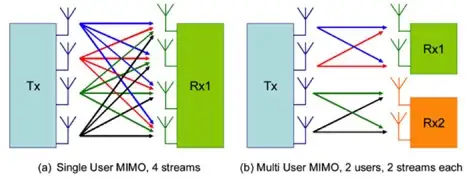
I have not seen MU-MIMO implemented yet, so I am not sure how this will be applied. This could be used in many ways and I wonder if intra-cell communications will be possible (avoiding the main network).
Conclusion
As with previous releases, I expect the vendors won’t implement all the capabilities called within the standards. The WiFi systems need to work with existing AP’s, networks, security and client devices and not all manufacturers will do the same thing.
I think the most exciting capabilities of WiFi6 is that we can operate 80MHz channels (with only four channels) at extremely high speed (2.4Gbps), while allowing us to create low speed sub channels for IOT and also the ability to re-use channels within close proximity to one another using the coloring scheme.
I noticed that one of our vendors (Aruba) has released an AP550 which supports 8×8 transmission capability on one 5GHz radio and two 4×4 transmission on each of two 5GHz radios. This could be really useful in high density wireless environments.
I am very interested to see how the vendors will manage the complex and dynamic communications regimes the standards allow ie RU/MU-MIMO/channel duty cycle. This is one of the things we are very keen to test in our LAB.
We have placed our initial orders for the 802.11AX and 802.11AD demo equipment and can’t wait to get it into the LAB. Stay tuned as we will release another blog to reveal the results of our testing.

